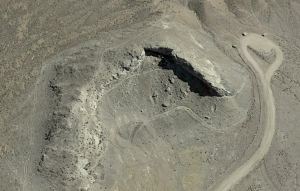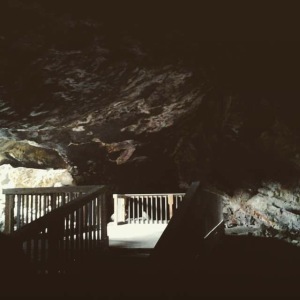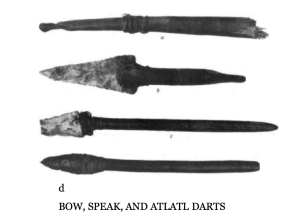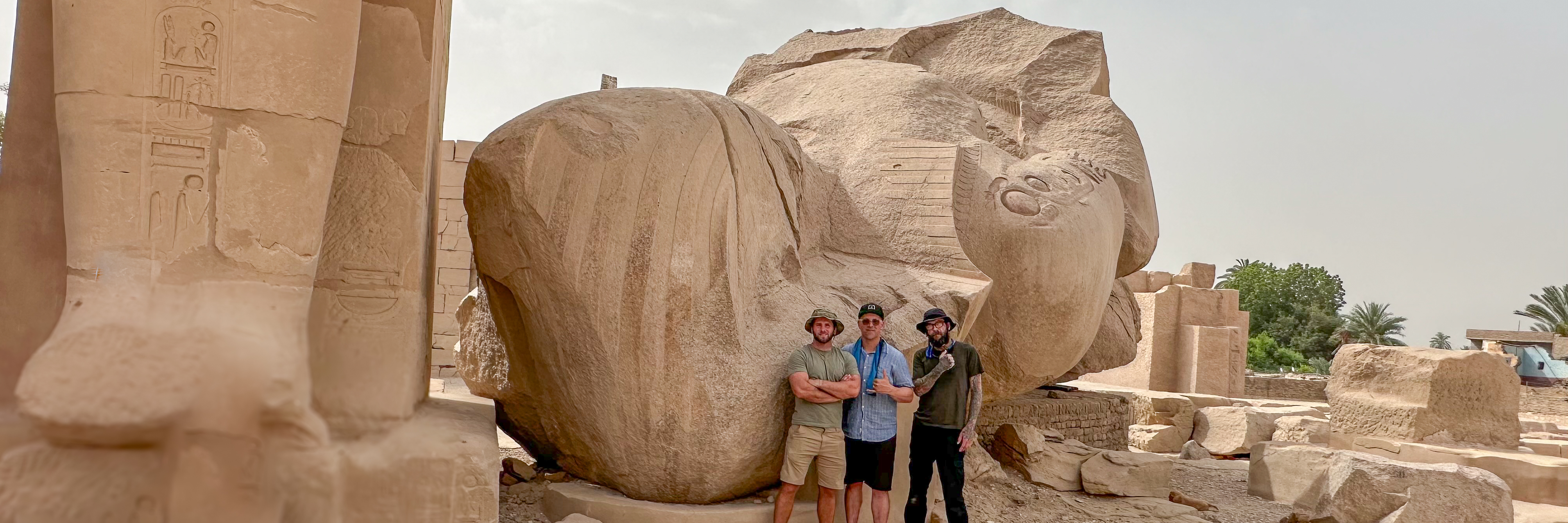
Tour Info / Register
A Megalithic Marvels Special Investigative Series
To read Part 1 of this series, click HERE
THE CAVE
About 93 miles northeast of Reno and situated inside an outcrop of limestone that forms part of the Humboldt Mountains, Lovelock Cave sits like an ancient fortress. As I entered this massive cave that is approximately 150′ x 35′ at its widest point, I felt as if I was going back in time. The first thing I noticed was that the entire cave roof was charred black from fire and smoke… But before I document the incredible discoveries found inside the cave, check out this quick video of my visit to this amazing site a few years ago…
THE ARTIFACTS AND SPECIMENS

In the autumn of 1911, a group of miners led by David Pugh and James Hart began digging out 250 tons of bat guano to be used as fertilizer when they began to discover countless well-preserved prehistoric artifacts. The University of California was notified and eventually sent out “L. L. Loud” in the spring of 1912 to conduct archaeological excavations at what is now known today as Lovelock Cave. Loud obtained over 10,000 artifacts and specimens from the cave. The collection was divided up between the Nevada Historical Society and the University of California. A further excavation was conducted in 1924 by the Heye Foundation who employed “M.R. Harrington,” who also collaborated with Loud. In their 1929 field guide titled “Lovelock Cave,” Loud and Harrington mention a few different dates regarding when ancient inhabitants might have first visited Lovelock cave with the oldest date being around 4000 B.C. However, a mummy found nearby in “Spirit Cave,” has since been carbon dated at around 10,000 B.C. 1 Unfortunately, Loud did not maintain a comprehensive report of the excavations so all of the detailed information is not available.
These archeologists found artifacts, specimens and remnants of advanced basketry, weaving, pipes, ice picks, nets, balls, knots, darts, horns, weapons, skin, human body parts, zoomorphic stone effigies and more… In their book “Lovelock Cave,” Loud & Harrington make the following statement…

“The preservation conditions in Lovelock cave are unusually favorable, recalling those of Egypt and Peru and being equaled at only a very few sites discovered in North America.”
The Phoebe A. Hearst Museum of Anthropology at the University of California wrote…
“Lovelock Cave, despite years of destruction, is one of the most important sites in the history of North American archaeology.”
But it gets better. The following are some of the most fascinating artifacts and specimens that were uncovered…
The Calendar
A donut-shaped stone with 365 notches carved along the outside and 52 corresponding notches along the inside, which some believe is a calendar.

The Decoys
Eleven duck decoys made of rush and tule were found painted and feathered and are considered to be some of the world’s oldest and most elaborate ever discovered. The original decoys are now preserved at the Smithsonian Institute in Washington D.C.
The Sandals
The sandals found inside Lovelock cave are not like others from the region. These tule sandals are known as V-Twined-Bag-type sandals, as they are made in the same way as woven bags. There are many reports that a pair of these sandals measured 15 inches long. 2
The Burnt Arrow Shafts
Loud and Harrington state “Tending to confirm the Northern Paiute legend of the assault on the cave are the fire-arrow foreshafts… A very large number of arrow fragments were found in the crevices of the rockfall blocking the mouth of the cave, as if they had been shot into it… as if fired by the flaming arrows mentioned in the legend.”

The Giant Weapon Shafts
I found several statements by Loud and Harrington that seem to indicate their surprise at finding extremely large arrow shafts. It’s almost as if it’s so hard for them to believe, that they surmise if the arrow shafts were made for different purposes…
“Of weapons we found only a large, heavy, pointed foreshaft of greasewood, larger than those commonly used for arrows…”
“The arrow fragments and foreshafts typical of the upper levels were not found in this one, but instead a single pointed foreshaft so large that it probably belonged to an atlatl dart rather than to an arrow.”
Q Were these abnormally large shafts made and used by the Si-Te-Cah to battle the Paiutes?
The Giant Pestle

The giant pestle was not discovered during the Loud & Harrington excavations, but was found some time after. Dr. Gene Hattori who is the curator of Anthropology at the Nevada State Museum makes the following shocking statement about the giant pestle… “We recently received a donation of a pestle that was found below the mouth of lovelock cave and it is extraordinary large and very heavy… it is much larger than we usually find… it was found below lovelock cave and well within the Si-Te-Cah territory. So this could have been one of the pestles used by the red headed giants & might account for its large size because of the large people that were using it.”
Q Why is this giant pestle only able to be seen in a private back room at the Nevada State Museum and not on display for public viewing?
It is pretty amazing to me that we now have both of the original archeologists who first excavated Lovelock cave, as well as the curator of Anthropology at the Nevada State Museum on record validating the oral tradition of the Paiutes and the written record by Sarah Winnemucca regarding a race of red-haired cannibalistic giants called the “Si-Te-Cah.”
Again in their 1929 book “Lovelock Cave,” archeologists Loud and Harrington state the following…
“The Northern Paiute have accounts of an extinct people living in various localities in Nevada which recall the beliefs in northwestern California regarding an ancient now extinct race of supernatural beings.”
Richard J. Dewhurst, Researcher and Emmy award-winning writer & author of the book “The Ancient Giants Who Ruled America,” says the following…
“The artifacts themselves prove that an advanced culture did indeed predate the Paiute Indians.”

The Humanoid
As I scoured the appendices in the back of Loud and Harrington’s field report, I was shocked to see this photograph of what appears to be a child-like humanoid that had been mummified and wrapped in a woven fur robe. Consider the size of the skull in comparison to the size of the body. Look at the placement of the large eye-sockets along with the smallish face and jaw. 3
Q Is this yet another strange genetic anomaly such as the red-hair and gigantic size of the “Si-Te-Cah?”
 Click here to read the ground-breaking investigative series “Easter Island Part 1: The Long-Ears, Civil War & the White-Skinned Cannibalistic Priests“
Click here to read the ground-breaking investigative series “Easter Island Part 1: The Long-Ears, Civil War & the White-Skinned Cannibalistic Priests“
References:
1 https://en.wikipedia.org/wiki/Lovelock_Cave
2 http://www.onlinenevada.org/articles/great-basin-prehistoric-footwear
3 Loud, L L & Harrington, M R, Lovelock Cave, (Kindle) 4426-4437, 1929


